 PMS or Premenstrual Syndrome is incredibly common; approximately 75% of all women will experience it some time during their fertile years. While many women experience only minimal problems other women experience more significant hormonal swings that can affect many areas of their lives.
PMS or Premenstrual Syndrome is incredibly common; approximately 75% of all women will experience it some time during their fertile years. While many women experience only minimal problems other women experience more significant hormonal swings that can affect many areas of their lives.
A staggering 150 different symptoms have been associated with PMT – here are just a few you may be familiar with:
Common Symptoms of PMS
- Anxiety
- Irritability
- Mood swings
- Cravings – mainly for sweets
- Tearfulness
- Fluid retention
- Breast tenderness
- Nervous tension
- Fatigue
PMS symptoms usually occur in the two week period between ovulation and menstruation, with a peak in symptoms in the week leading up to getting your period. In some women’s symptoms are relatively mild and lead to a chocolate binge and getting a bit teary, but for some unlucky women it can mean an absolute emotional and physiological upheaval for two weeks of each month.
PMS is usually broken down into 4 main categories – you may experience a mixture of symptoms from different categories.
PMS-A
Women with PMS-A usually experience emotional upheaval as their main PMS symptom. It is thought that it is related to a relative excess of oestrogen over progesterone.
Symptoms:
Anxiety
Irritability
Mood swings
Nervous tension
PMS-C
This is often found in conjunction with PMS-A and is thought to be associated with magnesium deficiency, insulin sensitivity or an imbalance in prostaglandins.
Symptoms:
- Cravings – mostly for sweets
- Dizziness or fainting
- Fatigue
- Headaches
- Increased appetite
PMS-D
This is possibly one of the most distressing types of PMS leading to emotional symptoms of depression, low mood, and feelings of hopelessness. This has been associated with an imbalance in oestrogen/progesterone ratios with some liver involvement.
Symptoms:
- Depression
- Low mood
- Feelings of hopelessness
- Social withdrawal
PMS-H
H stands for H2O retention. Women suffering from fluid retention often also experience PMS-C. Relatively high prolactin levels and low progesterone levels are thought to be a contributing factor.
Symptoms:
- Fluid retention
- Breast tenderness
- Premenstrual weight gain
 When things get scary
When things get scary
A more sinister manifestation of PMS is Premenstrual Dysphoric Disorder or PMDD, characterized by serious depression. This is a serious condition that requires professional diagnosis and treatment.
The Hormonal Symphony
Women’s hormones are very complex and interrelated, it’s a bit like a symphony with every instrument in the orchestra having to play its part at the right time in the right way. If a level of hormone becomes elevated or lowered it then throws the entire range of hormones out of balance.
What Causes PMS?
There are several ways hormones can become out of balance; nutritional deficiencies play a role as does stress, excess body fat, poor GIT and liver function and an unhealthy diet and lifestyle.
Stress Plays a Role
Sometimes PMS can be caused by an abnormal response to normal hormones levels. Stress increases the levels of adrenal hormones called epinephrine and norepinephrine. These hormones act to block progesterone receptors in the body, decreasing the cells response to normal progesterone levels. This creates a ‘relative’ imbalance and contributes to PMS. This can be very confusing if you decide to get a blood test to check your hormone levels and find that everything seems to be in order – it may be that stress is playing a role.
The Fat Facto r
r
if you’re carrying around excess body fat then perhaps it’s time to consider a change of diet and lifestyle. Oestrogens can be converted in your peripheral fat tissue adding to your total oestrogen load and contributing to an imbalance between oestrogen and progesterone.
Gut Bugs
As strange as it may seem, the bacteria in your digestive tract plays a major role in oestrogen metabolism. Normally oestrogens pass through the liver where they are conjugated by one of the Phase II liver detoxification pathways known as glucoronidation. They are then passed into the gastrointestinal tract (GIT) to be excreted. If you have an overgrowth of bad bacteria in the GIT (known as dysbiosis)the bacteria are able to break the bond between oestrogen and beta-glucoronidase so the instead of being safely excreted the oestrogen will be reabsorbed back into the blood stream causing an oestrogen excess, and you guessed it, increasing symptoms of PMS. Dysbiosis is far more common than you may realize, in the medical center I work in all patients do a simple urine test to check for dysbiosis, approximately 80% are positive!
Prolactin
Elevated levels of prolactin (hyperprolactinemia) or excessive sensitivity to prolactin (latent hyperprolactinemia), is considered the hallmark of PMS. Prolactin is the hormone responsible for lactation,and normally levels increase directly after birth, however it is also released in response to stress. Even minor stress can elevate prolactin levels.
Hyperprolactinemia is characterised by low progesterone levels and normal to mildly elevated prolactin levels. Prolactin is usually held in check by progesterone, if progesterone levels dip, as they do towards the end of the menstrual cycle a hormonal imbalance occurs contributing to symptoms of PMS.
 Irregular Cycle
Irregular Cycle
If you are experiencing irregular cycles you may not be ovulating, remember that in order to produce progesterone we need to ovulate. If this happens it will lead to a relative oestrogen excess, and you guessed it – PMS. Women who experience symptoms of breast tenderness and fullness premenstrually can blame that on problems with prolactin.
Sluggish Liver
As your hormones are metabolized and eventually pass through your liver on their way out of the body it makes sense that an overloaded liver will struggle to process your hormones. A poor diet and stress can contribute to sluggish liver function. If your are having ongoing hormonal problems and just can’t seem to get things in balance it’s time to go on a Detox. Detoxing should be professional supervised to ensure you get the best results; a 3 day juice fast does not constitute a Detox! In fact incorrect detoxing will only add to the problem – so get some advice and do a proper Detox Programme, your body will thank you for it!
Basically there are many reasons women experience hormonal imbalance and PMS, too many to fully cover here. The most important thing to know is that you can regulate your hormones naturally and not let PMS ruin your life/relationships/career!
Natural Treatments for PMS
An unfortunate misconception is that PMS is just “one of those things women have to put up with” – This couldn’t be further from the truth. I consider hormones a part of our early warning system, if things aren’t working as they should in your body generally your hormones will let you know.
Natural Medicine provides many effective treatments for hormonal imbalance and PMS.
Herbal Medicine
Well, where do I start…. herbal medicine has been used for centuries to help regulate female hormones. Some of the most commonly used herbs that do this are:
- Dong quai
- Peony
- Shativari
- Wild yam
Often these are combined with other herbs that help to support the nervous system, adrenal, gut and liver function to gently bring hormones back into balance.
Vitex agnus-castus
One herb that deserves a special mention when it comes to the treatment of female hormonal imbalance and PMS is Vitex, commonly known as Chaste Tree. It has been traditionally used for centuries to balance female hormones, support fertility and treat PMS. Several clinical studies have confirmed it’s effectiveness and it is recommended by the British Herbal Pharmacopea as a specific treatment for PMS. It is considered a progesterogenic herb (increases progesterone) as it encourages ovulation, increases progesterone and helps rebalance oestrogen/progesterone ratios when there is a relative oestrogen excess – one of the major causes of PMS.
Vitex also reduces prolactin levels effectively in a dose dependent manor. A low dose of Vitex will elevate prolactin, where a higher dose effectively lowers prolactin. High prolactin levels or an increased sensitivity to prolactin is one of the hallmarks of PMS as previously mentioned. This fabulous herb is very effective in the treatment of PMS but needs to be professional prescribed.
 Nutrition
Nutrition
Good nutrition counts for a lot when it comes to your hormones; magnesium, B6 and zinc are the golden triangle of nutrients for healthy hormone balance. An excellent diet and women’s multivitamin will really help. If you are suffering from PMS it is best to get professional nutritional advice – analysing the diet can be quiet revealing!
Detox
As mentioned a thorough systematic Detox Programme will not only help you look and feel fabulous it will help to ensure that your liver and GIT is working well and is able to effectively metabolize and excrete your hormones.
Fat Loss
Natural Medicine takes a scientific approach to fat loss. Many diets cause you to lose fat and muscle which eventually leads to muscle loss and rebound fat gain which messes with your metabolism. Extra body fat will contribute to relative oestrogen excess – so get some professional advice, you’ll feel great and look good too! In closing the most important thing to remember is that PMS is caused by hormonal imbalance and can be safely and effectively treated.
 So next time you find yourself on the couch with a family sized block of chocolate and a box of tissues in tears after a hormonally induced hissy fit maybe you should consider the Natural Medicine approach!
So next time you find yourself on the couch with a family sized block of chocolate and a box of tissues in tears after a hormonally induced hissy fit maybe you should consider the Natural Medicine approach!

